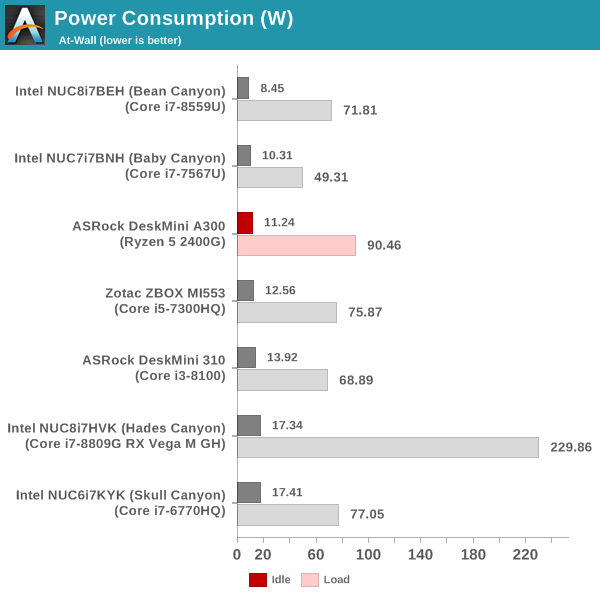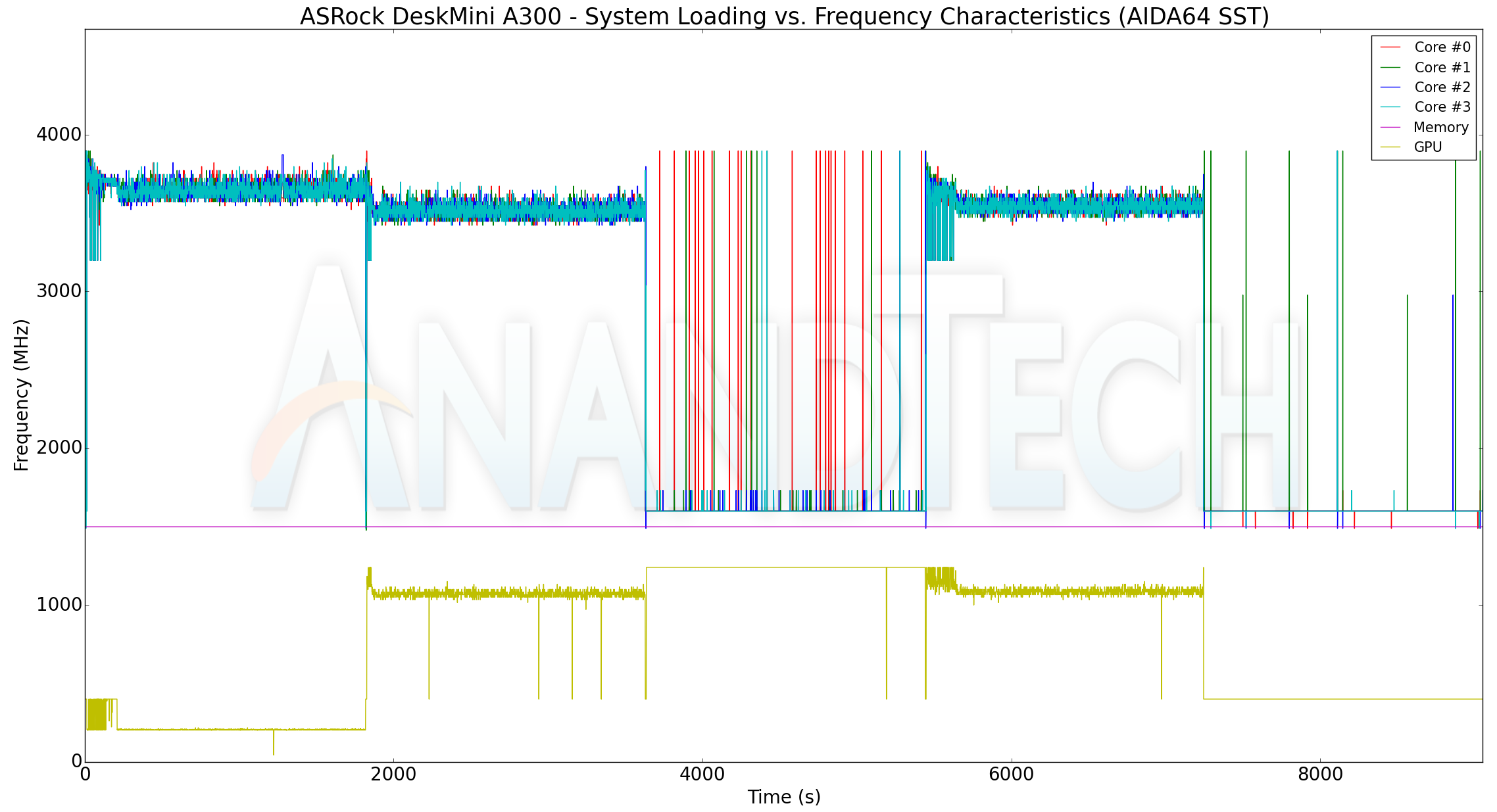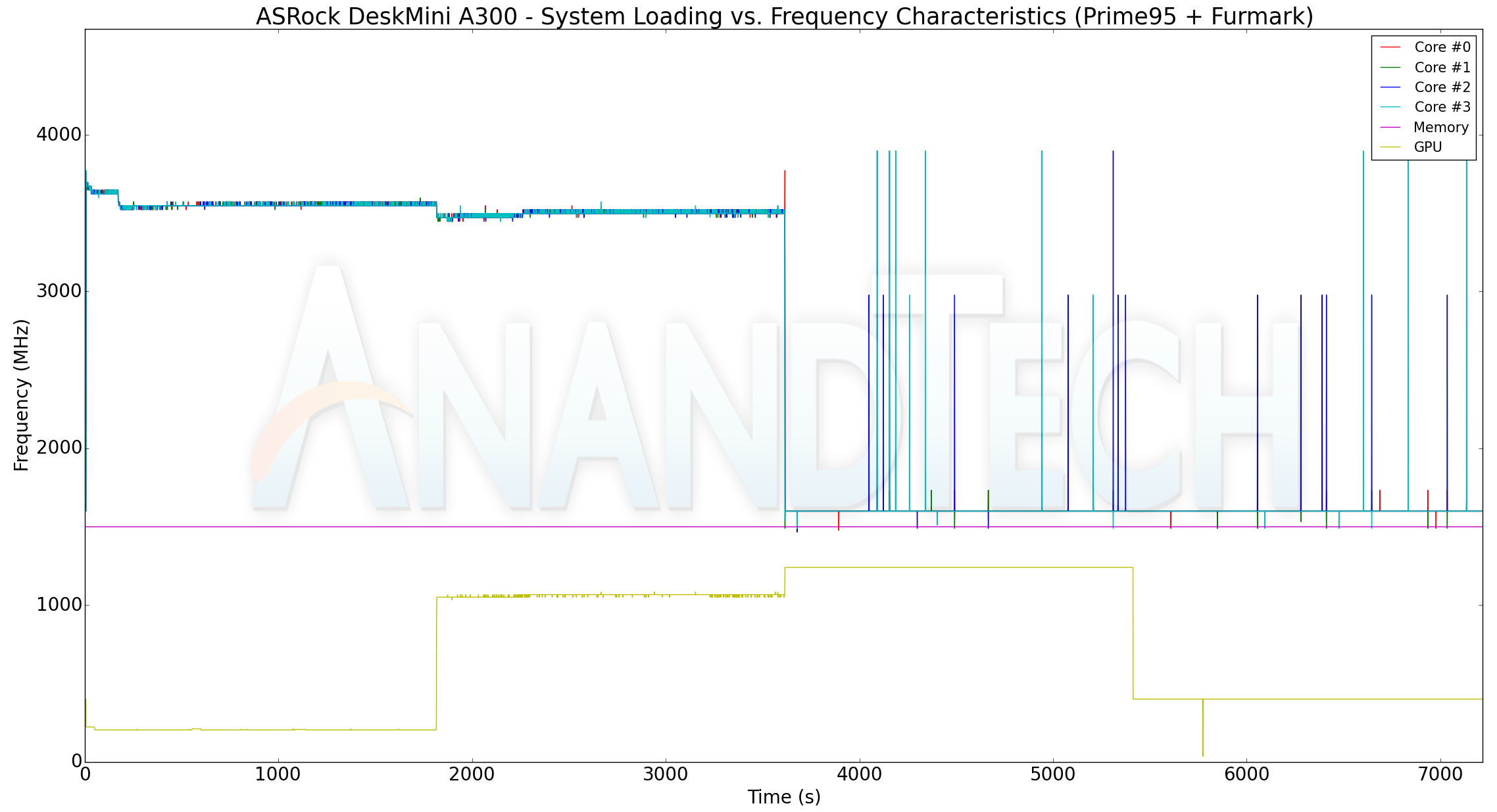The ASRock DeskMini A300 Review: An Affordable DIY AMD Ryzen mini-PC
by Ganesh T S on April 26, 2019 8:00 AM ESTPower Consumption and Thermal Performance
The power consumption at the wall was measured with a 4K display being driven through the HDMI port. In the graphs below, we compare the idle and load power of the ASRock DeskMini A300 with other SFF PCs evaluated before. For load power consumption, we ran the AIDA64 System Stability Test with various stress components, as well as a combination of Prime95 and Furmark, and noted the maximum sustained power consumption at the wall.

The key comparison here is against the DeskMini 310. Thanks to the use of a more power-efficient NVMe SSD, and the A300 PCH that essentially acts as a transparent bridge, the idle power consumption of the DeskMini A300 is a full 2W lower than the DeskMini 310. The load case, however, is completely different. We see the DeskMini A300 sustaining more than 90W at the wall. This number is higher than the load consumption of any other iGPU-only system we are comparing against.
Our thermal stress routine starts with the system at idle, followed by four stages of different system loading profiles using the AIDA64 System Stability Test (each of 30 minutes duration). In the first stage, we stress the CPU, caches and RAM. In the second stage, we add the GPU to the above list. In the third stage, we stress the GPU standalone. In the final stage, we stress all the system components (including the disks). Beyond this, we leave the unit idle in order to determine how quickly the various temperatures in the system can come back to normal idling range. The various clocks, temperatures and power consumption numbers for the system during the above routine are presented in the graphs below.
| ASRock DeskMini A300 System Loading with the AIDA64 System Stability Test | |||

At the start of our stress routine, we see most of the cores at the boost clock (3.9 GHz), but, the temperature quickly approaches 78C. The DeskMini A300 BIOS seems to treat that as the indicator to bring down the cores to the base clock of 3.6 GHz. In this initial period, the package power (labeled as reported, but, is more likely to be the power consumption of the x86 cores alone) is around 35W. That drops down to 30W after the cores go back to the base clock. After adding the GPU loading, the cores clocks do go down a bit to around 3.4 GHz (as the GPU ramps up from around 200 MHz to around 1.1 GHz). The reported package power remains constant at 30W. Unlike the reported package power, the at-wall power consumption provides hard irrefutable numbers. In the boost clock state, the wall power goes as high as 80W before settling down to around 72W. When the GPU load is added, the metric stabilizes around 85W. If the GPU alone is loaded, the core clocks jump down to 1.6 GHz, and the GPU starts running at the rated clock (1250 MHz). The at-wall consumption is around 43W. When stressing everything in the system, the added storage workload slightly bumps up the at-wall consumption by a couple of watts, but, other metrics remain similar to the second stage. The temperature of the cores never exceed 80C at any point in the AIDA64 system stability test.
We also run a custom stress test involving Prime95 and Furmark. Starting with Prime95 alone, we add Furmark to the mix after 30 minutes. After another 30 minutes of simultaneous CPU and GPU loading, we terminate the Prime95 process alone and let the GPU run at full throttle. The metrics graphed for the AIDA64 system stability test are also graphed here.
| ASRock DeskMini A300 System Loading with Prime95 and Furmark | |||

Interestingly, Prime95 doesn't trigger the boost clocks for the cores. Otherwise, the loading characteristics for the frequencies, temperature, and power are largely the same as what we observe with the AIDA64 system stability test workloads. The only thing of note is that Prime95 and Furmark together make the system consume north of 90W at the wall.
The thermal solution is very effective, ensuring that the temperatures never cross 80C while allowing the APU's CPU cores and GPU to operate at the advertised frequencies / rated power consumption. The 90W peak power consumption also indicates that the Ryzen 5 2400G is operating at its rated TDP of 65W in the DeskMini A300.










88 Comments
View All Comments
abufrejoval - Friday, April 26, 2019 - link
Very nice review!But surprisingly little relative change (relative to publicity...) from the previous (major) iteration, which I interpret as the Kaveri vs. Skylake Iris Plus that I own and tested, A10-7850k vs. i5-6267U.
Intel still seems to never use more than 15Watts for the CPU, yet manages scaling single to 4GHz at great IPC while it manages to sustain admirable Hertz even at multi-core constant loads, taking a nice sip of cool on every little stall. AMD seems to retain a much more linear efficiency curve where clocks and cores just eat power, while the difference at the wall plug is much smaller in this iteration (was 3:1 for exactly the same performance on my old systems).
The good thing is that on a device like this, peak power is much less important than on a notebook, so it’s ok, as long as maintains quiet on constant peak and (finally) reaches acceptable idle: Here I see a lot of progress on AMD's side, Intel has much less room to beat itself.
For graphics, bandwidth is so crucial and I wonder what the AMD could do with a bit of eDRAM, HBM or even a lower-power variant of GDDR5… but I guess the latency issues could kill browser performance and that is unfortunately a large chunk of what buyers would want these for…
Still dreaming of a way to put well-proportioned APUs in a scalable system with 1x/2x/4x configs… With storage and RAM no longer eating box space, 75/150/300 Watt configs could be relatively small yet remain quiet.
Speaking of idle power and quiet, this is where I get interested in the AMD. The NUC is great in everything but noise on peak load, but it would really only take a replacement top and a Noctua to make it great… There is so much space behind these giant 4k screens, nuc/NUC can become a little pointless.
Good Linux support is where I am getting concerned. Current reports praise AMD on their Linux vision… but progress seems a very different story and one where Intel (sorry Charly), really shines, even Nvidia seems better in practical terms (sorry Linus). I’m also somewhat disheartened by power management there: Not sure I’ll be able to reach 10 Watt of idle on CentOS or Ubuntu *and* Steam/Vulkan performance comparable to Windows (it’s actually gotten quite good on bigger Nvidia GPUs, even GPU pass-through to a Windows VM is kind of fun).
sor - Saturday, April 27, 2019 - link
As I mentioned probably as you were typing this, I ran Ubuntu straight out of the box and am getting nearly 50% better FPS than this review on Dota 2. Full vulkan support and max settings. Pleasantly surprised, I am used to having to tinker with drivers.Notably, I don’t think this would have been possible 8 months ago as only newer kernels have the good AMD support built in.
Pishi86 - Saturday, April 27, 2019 - link
This is not exactly a fair comparison. You are comparing a desktop AMD chip with and a mobile Intel chip. Its kind of like comparing an i3 8100 vs a Ryzen 5 3500u. AMD's Ryzen 5 3550H and Ryzen 7 3750H would have been more competitive. These chips are about as fast as the 2400G, but with an maximum TDP of 35w. There are some reviews on Notebookcheck and these chips are consuming just over 70w underload. This is with a 15.6 1080P screen and a power hungry Radeon RX 560X. The power consumption and battery life is actually better than an i5 8300H and 1050 combo with an identical. Check out the review below.https://www.notebookcheck.net/Asus-TUF-FX505DY-Ryz...
The truth is the onboard Vega on Ryzen is a very powerful iGPU held back by memory bandwidth. Unrestrained, its probably 80-90% as powerful as an RX 460. It has 640-704 Vega cores which are clocked higher (1.2-1.4GHz) than the 896 cores in the RX 460. Vega's IPC should be a bit above Polaris's.
I agree with you Linux support is spotty, I am a Linux user myself and I am in the market for a new laptop, but I may have to buy Intel despite its weak iGPU. Unfortunately, you can't find anymore Iris powered laptops these days (outside the macbook pro). Also, even though its improved AMD's video decode/encode is not as efficient as Intel's. I am not even sure if Nvidia is as efficient as Intel in video playback. Having that said I would not trust Intel's UHD graphics powering a 4k monitor, which is what I am in the market for.
Pishi86 - Friday, April 26, 2019 - link
Does anyone know if you could get a 3rd party power supply that's more than 120w? I mean 150w might be good, if AMD releases 95W APUs in the future. A 120W PSU might limit CPUs abover 65W.Lucky Stripes 99 - Sunday, May 5, 2019 - link
Yes, there are third party power bricks available that can supply more current. Just keep in mind that the power regulators on the motherboard may not be rated for that higher current and that you could shorten its life or run into stability issues if you attempted to use a more power hungry processor (assuming if the BIOS would even make it past POST with an unsupported processor).Haawser - Saturday, April 27, 2019 - link
Good luck buying one...Only EU retailers I could find seem to have sold out within hours. Still, will keep trying. As this is exactly the sort of SFF I've wanted since Ryzen APUs came out.ganeshts - Saturday, April 27, 2019 - link
On Amazon and Newegg, Computer Upgrade King seems to have lot of ready-to-go models with the DeskMini A300 ; Eg: https://www.newegg.com/Product/Product.aspx?Item=9... (Just FYI - I have no idea about the reputation of this retailer. Just came up during my search on Google)Haawser - Saturday, April 27, 2019 - link
@ganeshts- Again, out of stock. Personally I think ASRock, Lenovo, HP, Zotac and everybody else that manufacturers SFF PCs have greatly underestimated the number of people looking to buy Ryzen APU based systems. And with the improved 3000 series (12nm Zen+ with soldered HS) soon available, the barebones will be even more sought after.ganeshts - Sunday, April 28, 2019 - link
Shows in-stock for me when I added to cart : https://i.imgur.com/YWbYlJ6.pngoliwek - Saturday, April 27, 2019 - link
For people in NL or BE, I bought mine from here, delivered promptly : https://www.megekko.nl/product/2321/237330/Barebon...